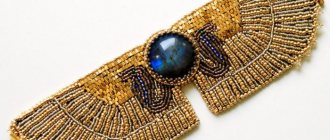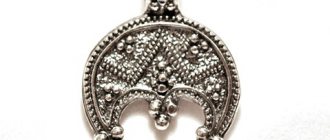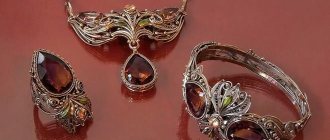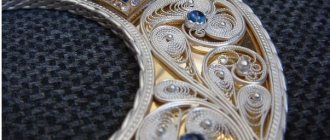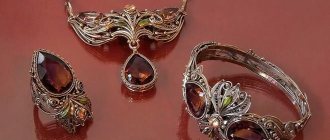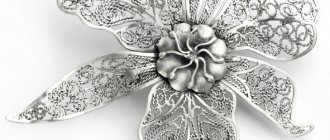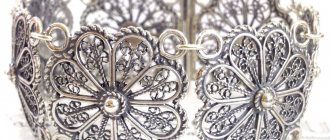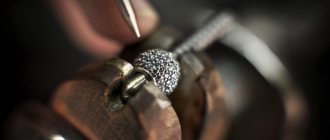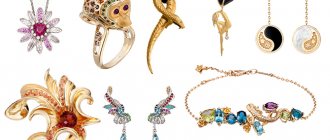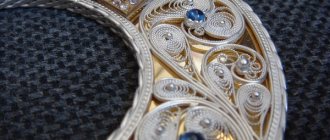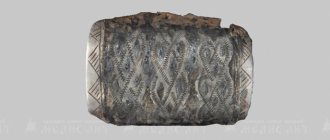Almost everyone is familiar with the expression “filigree work,” but few have any idea of its origin. Filigree is a type of jewelry craftsmanship, the finest interweaving of silver threads from which real masterpieces are created.
The technique is well known to the masters of yesteryear, who created products that have survived to this day.
Filigree and filigree
The only differences are in the origin of the words; they denote one type of jewelry art. The name “scan” comes from the Old Russian word “skat”, meaning “to twist”, “to twist”, which accurately reflects the essence of the work.
The word “filigree” comes from Latin words that are translated as “grain”, “thread”.
Interesting! Jewelry art was actively used all over the world. In famous museums you can find filigree jewelry dating back to the 6th century BC.
Who owns the filigree technique: historical background
It is believed that the first masters who mastered this interesting technique appeared in Ancient Egypt and ancient Greece. The oldest items discovered during excavations of ancient cities date back to the 6th century BC.
The rapid growth in popularity of filigree products was noted in the 18th century.
European craftsmen created unique jewelry for wealthy citizens and nobles. The 19th century is rightfully considered the heyday of filigree crafts. At this time, jewelry began to be mass produced and was available to almost all classes.
Russian filigree originates in ancient centuries. Filigree in Ancient Rus' was primarily a ritual item, which then migrated to the princesses’ boxes.
The famous Krasnoselskaya filigree created a worldwide sensation at the Paris Exhibition in 1937. Success was repeated 2 years later in New York.
Traditional blackening in Europe
In Europe, blackening of metals began in the 15th century; alchemists and jewelers invented a similar mixture that etched the metal: a mixture of silver, sulfur, and lead. The essence of traditional European blackening (English blackening, blackened silver, historically - niello, Italian niello, from Latin nigellus, diminutive from niger - black) is this: a “black” alloy of silver, copper, lead and sulfur is smelted into the base metal.
When heated, a chemical reaction occurs between the silver and the melted mixture. As a result, in addition to new decorative properties, the blackened product also receives practical ones: it does not fade and does not require special care. The palette of niello is wide - from silver-gray to black-velvet tones.
Niello is very beautiful on both high-grade gold and silver, but is not suitable for metals such as copper and brass. The layer of niello crumbles after firing and falls off. It is very difficult to determine the percentage of metals used for blackening if work is carried out on low-grade gold and silver. The master cannot predict what reaction the base metal and the poured mixture will have at a certain temperature, so jewelers continue to experiment, constantly changing the composition of the mixture, adding new components and changing the melting point.
Types of jewelry filigree
Depending on the technique used to create the work of art, there are several types of filigree.
Brazed filigree
This type of filigree was popular in medieval Europe. The method involves soldering a silver thread onto a previously prepared metal plate.
If the plate remains in the finished product, then this type is called background or “blank”. In some cases, the background is sawed out, resulting in a cut-out filigree.
Openwork filigree
The main feature of openwork filigree is the absence of a background. A pattern is assembled from silver threads soldered together. The grain is soldered onto the wire. If it is not in the product, then it is called flat lace.
Two- and three-dimensional volumetric filigree patterns are called sculptural-relief filigree.
Volumetric filigree
Separately, we should highlight products made using the volumetric filigree technique. Often, such filigree takes the form of household items, dishes, figurines of birds and animals.
Due to the increased complexity of the product, individual filigree elements are first created, which are then combined into one whole.
Interesting! In jewelry production, you can find all three filigree techniques, depending on the type of product.
Blackening silver at home
There are two ways to do this: oxidation and traditional blackening. And the difference between these two methods is colossal.
During oxidation, silver is covered with a thin film of oxides, so the product receives a dark coating. But the coating is short-lived and easily erased. The difference is especially noticeable when cleaning - if you polish oxidized silver, it becomes covered with a network of lighter spots.
Blackening is the coating of a metal surface with a mixture of silver, copper and lead sulfides. This coating is resistant to abrasion and completely disappears only with prolonged boiling or exposure to acid.
Blackening of silver with graphite
A simple mechanical method will help you darken silver jewelry yourself. Graphite accelerates the natural aging process of lunar metal; microcracks appear on the surface of the product, which quickly turn black, creating a coating of noble patina.
It is necessary to mix in equal proportions turpentine, graphite powder (pencil lead will do) and iron oxide (black iron oxide - Paint called “Black Mars”. It is iron oxide, is a mineral black pigment. Unlike all black carbon paints (soot, ivory, etc.) dries well in oil painting, but is inferior in color depth). Apply the paste to the silver jewelry and wait until it dries completely.
Wipe the decoration with a cloth, or rinse lightly with water. You will receive niello in its most primitive form; such a coating may wear off over time, but as a decorative niello it is suitable for home processing.
Blackening silver with an egg
What do rotten eggs smell like? Hydrogen sulfide (H2S). And it is sulfur that is used for classic niello. In the recipe, we will not use a radically smelly method and wait for the eggs to spoil; freshly boiled eggs also release sulfur. This effect is used for home blackening.
- Boil 2 eggs, separate the yolk from the white.
- The yolk must be mashed and placed on the bottom of an airtight jar or saucepan.
- Place a paper towel or napkin on the eggs, and place silver jewelry on the napkin.
Close the container with a tight lid and wait a day. The silver will be covered with a uniform layer of oxide film and acquire the color of real black. If you do not use a separator in the form of a towel, but dip the silver in the yolk, you can cause the product to blacken unevenly. After such home blackening, the jewelry is washed with soap and polished with a soft cloth.
Black on silver using iodine
The easiest way to blacken silver at home is to use iodine. It is not known who first tried this method, but it works quite well and allows you to achieve the desired effect.
- Clean your silver item.
- Apply iodine to the surface of the jewelry with a cotton swab and leave the jewelry to dry, preferably in the sun.
- After an hour, clean the product with toothpaste; niello will remain in the recesses of the jewelry, and the convex parts will shimmer with silver.
- If you need to achieve a more pronounced blackening effect, repeat the procedure.
The disadvantages of this technology are obvious: this blackening method is suitable for embossed products, but is not suitable for jewelry with a smooth surface.
Sulfuric ointment
You can quickly and effectively darken silver using sulfur ointment. This is a medicine that is mainly used to combat scabies pathogens in both humans and animals. Therefore, it is sold both in veterinary and regular pharmacies.
Sulfur ointment is thick, yellow in color and has a rather unpleasant odor. It must be applied to the product, and then heated to a fluid state using a hairdryer. After the ointment has transformed into a more liquid state, it can be carefully distributed on the surface of the silver. When heated, you will see how the metal acquires a rich black-blue or purple color. Afterwards, the product can be wiped dry; if necessary, the procedure can be repeated.
Also at home, in order to darken silver, they use “sulfur liver” - a sintered mixture of sulfur and soda, which is thrown into water with silver. But it is not recommended to use this blackening technique at home, since the process will release hydrogen sulfide, a dangerous gas with an unpleasant odor.
How filigree jewelry is made
Filigree combines several basic elements that make up the finished pattern - rope, lace, herringbone, wicker, track. Sometimes grains - small metal balls - are added to jewelry.
They are soldered onto the surface of the main pattern, repeating it. Such decorations look unusual and elegant.
Silver is often used to make filigree items. You can find jewelry made of gold, brass, cupronickel, and copper.
Jewelry of any complexity is created using the filigree technique. The final cost depends not only on the material used, but also on the complexity of the technology.
Silver filigree: manufacturing technology
In ancient times, a jewelry master was engaged in the manufacture of filigree from the development of a sketch to the final polishing of the product.
Today, large productions divide the work into stages, so a whole team of specialists is involved in the manufacture of one piece of jewelry. Private jewelers still make their own filigree. Schemes of patterns and motifs are passed on from master to student.
Production begins with the production of thin metal wire. To do this, a solid silver bar is heated, softened, and then drawn out. Rolls out to the desired length and thickness.
The rock patterns are assembled from individual elements, so the next stage is their manufacture. A thin wire is bent using special tweezers - a forceps.
The finished parts are applied to paper with a pre-drawn drawing of the product. If all the elements are assembled, then the master starts soldering. The openwork elements are securely fastened together, forming a single whole.
A well-made product is durable, despite its external tenderness and airiness.
The final stage of production is rhodium plating of silver jewelry and silver plating of metal jewelry (pure 999.99 silver is used for this). In some cases, artificial aging is performed by oxidizing the metal.
Methods of applying niello
Textbooks for jewelers (for example, “Technology of jewelry production, V.P. Lugovoy, 2013) tell that there are two ways to apply niello - dry and wet. When dry, the surface is moistened with the necessary solution and finely ground black powder is applied. Carefully dry, fire in a muffle (300-400 ° C). With the wet method, the composition is applied in the form of a creamy slurry diluted with water.
The mixture is applied thickly and tightly into the recesses with a brush or spatula. Waiting for the water to evaporate. Afterwards, when heated in the muffle, the niello softens, melts, flows into the design and covers the object. This is a sign to remove the item from the stove. Small decorations can be melted with a soldering gun. The heat flow is concentrated on the base metal, and it is better to heat it from the reverse side. When the mass melts, heating is completed.
Now the product is “cleaned up” by scraping or filing with a file (“removal”) until a pattern appears. The main thing is not to grab or cut down the ornament itself. Then the product is ground and polished, revealing the entire pattern. Often the background of the object is additionally engraved or shot (shotting is the application of dots, strokes or notches on the surface of the metal).
The history of the heyday of filigree
The growing popularity of unusual technology begins in the 17th century. Masterpieces are created that compete with crystal vases, figurines, and household items.
Production technology is becoming more complex: techniques are used to combine metal filigree patterns with enamel, crystal, mother-of-pearl, and semi-precious stones.
The decline in the popularity of jewelry began during the First World War.
Kazakovskaya filigree – modern production
To this day, the Kazakovsky Art Products Enterprise has been developing and producing unique works of art. Kazakovsky filigree is distinguished by its openwork and airiness.
View this post on Instagram
Posted by Russian Souvenirs Store (@russiangifts) Jan 31, 2018 at 7:51 PST
Design artists spend a lot of time working on every detail so that the product looks harmonious using classical technology.
Interesting! Filigree may seem old-fashioned, but it is not. The company keeps up with the times, offering interesting solutions - devices for consuming tobacco, alcohol, cases for flash cards, trays, and interior figurines.
Filigree from "Kubachi"
The Kubachi jewelry factory launched its production in the village of the same name. The products are known throughout the country. The uniqueness of the jewelry lies in the combination of classical filigree techniques with embossing, engraving, and Dagestan blackening.
View this post on Instagram
Posted by Murad (@murad_yusbashev) Jan 22, 2022 at 9:43 PST
The result is completely non-trivial things.
Products with filigree elements versus true filigree
Certain elements of scanned technology are widely used to make jewelry. For example, grains can often be found in rings and earrings. Combining techniques makes it possible to get an interesting result.
Classic filigree is too pretentious for everyday wear. The buyer will prefer a simpler product, but with filigree elements.
Grain and filigree of Ancient Rus'
The technique of making jewelry began to be used on the territory of the Russian state in the 10th century. This period is characterized by an abundance of grains of different sizes and a small variety of filigree elements. Then the production technology developed to the production of soldered filigree; from the 12th century, craftsmen mastered the technique of openwork, relief filigree.
During the time of Tsarist Russia, filigree items were made in different sizes - from large-scale canvases to small brooches and earrings. The most famous masters were Ambrose and Ivan Fomin, whose products have survived to this day.
False (cast) filigree and grain
These techniques appeared to reduce the cost of the manufacturing process and speed it up. False (cast) filigree and grain are products cast in pre-made slate and limestone molds. Such decorations are similar to the original filigree decorations, but differed from them in simpler, smooth designs without relief.
